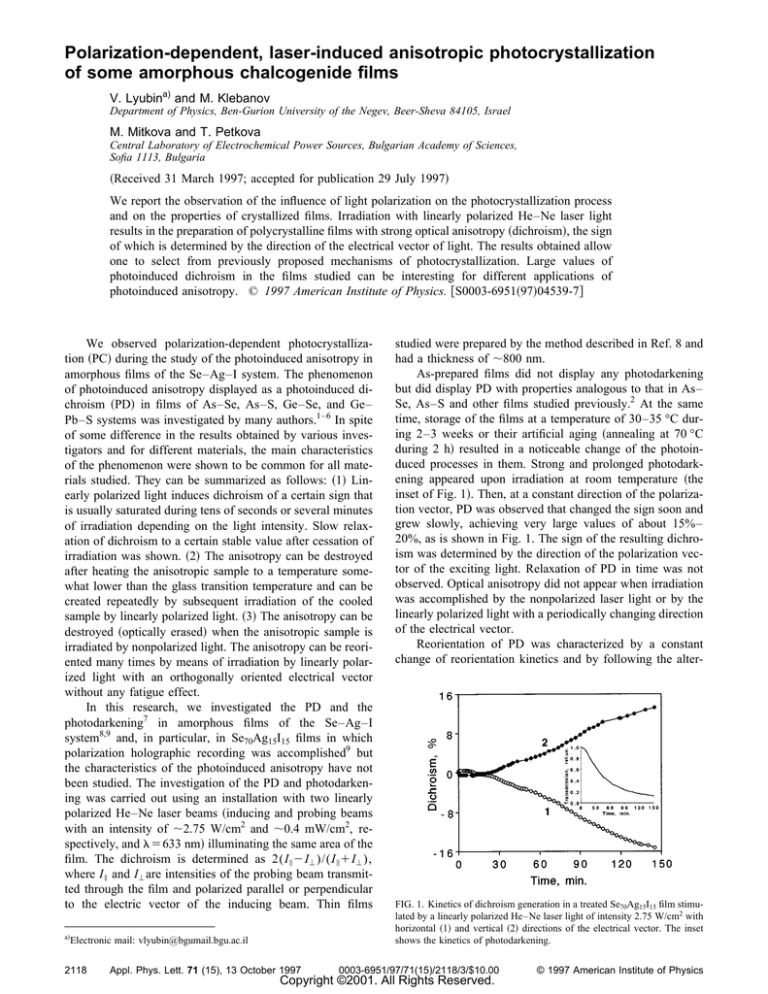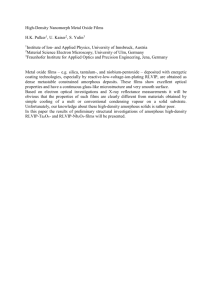
Polarization-dependent, laser-induced anisotropic photocrystallization
of some amorphous chalcogenide films
V. Lyubina) and M. Klebanov
Department of Physics, Ben-Gurion University of the Negev, Beer-Sheva 84105, Israel
M. Mitkova and T. Petkova
Central Laboratory of Electrochemical Power Sources, Bulgarian Academy of Sciences,
Sofia 1113, Bulgaria
~Received 31 March 1997; accepted for publication 29 July 1997!
We report the observation of the influence of light polarization on the photocrystallization process
and on the properties of crystallized films. Irradiation with linearly polarized He–Ne laser light
results in the preparation of polycrystalline films with strong optical anisotropy ~dichroism!, the sign
of which is determined by the direction of the electrical vector of light. The results obtained allow
one to select from previously proposed mechanisms of photocrystallization. Large values of
photoinduced dichroism in the films studied can be interesting for different applications of
photoinduced anisotropy. © 1997 American Institute of Physics. @S0003-6951~97!04539-7#
We observed polarization-dependent photocrystallization ~PC! during the study of the photoinduced anisotropy in
amorphous films of the Se–Ag–I system. The phenomenon
of photoinduced anisotropy displayed as a photoinduced dichroism ~PD! in films of As–Se, As–S, Ge–Se, and Ge–
Pb–S systems was investigated by many authors.1–6 In spite
of some difference in the results obtained by various investigators and for different materials, the main characteristics
of the phenomenon were shown to be common for all materials studied. They can be summarized as follows: ~1! Linearly polarized light induces dichroism of a certain sign that
is usually saturated during tens of seconds or several minutes
of irradiation depending on the light intensity. Slow relaxation of dichroism to a certain stable value after cessation of
irradiation was shown. ~2! The anisotropy can be destroyed
after heating the anisotropic sample to a temperature somewhat lower than the glass transition temperature and can be
created repeatedly by subsequent irradiation of the cooled
sample by linearly polarized light. ~3! The anisotropy can be
destroyed ~optically erased! when the anisotropic sample is
irradiated by nonpolarized light. The anisotropy can be reoriented many times by means of irradiation by linearly polarized light with an orthogonally oriented electrical vector
without any fatigue effect.
In this research, we investigated the PD and the
photodarkening7 in amorphous films of the Se–Ag–I
system8,9 and, in particular, in Se70Ag15I15 films in which
polarization holographic recording was accomplished9 but
the characteristics of the photoinduced anisotropy have not
been studied. The investigation of the PD and photodarkening was carried out using an installation with two linearly
polarized He–Ne laser beams ~inducing and probing beams
with an intensity of ;2.75 W/cm2 and ;0.4 mW/cm2, respectively, and l5633 nm! illuminating the same area of the
film. The dichroism is determined as 2(I i 2I' )/(I i 1I' ),
where I i and I' are intensities of the probing beam transmitted through the film and polarized parallel or perpendicular
to the electric vector of the inducing beam. Thin films
a!
Electronic mail: vlyubin@bgumail.bgu.ac.il
2118
Appl. Phys. Lett. 71 (15), 13 October 1997
studied were prepared by the method described in Ref. 8 and
had a thickness of ;800 nm.
As-prepared films did not display any photodarkening
but did display PD with properties analogous to that in As–
Se, As–S and other films studied previously.2 At the same
time, storage of the films at a temperature of 30–35 °C during 2–3 weeks or their artificial aging ~annealing at 70 °C
during 2 h! resulted in a noticeable change of the photoinduced processes in them. Strong and prolonged photodarkening appeared upon irradiation at room temperature ~the
inset of Fig. 1!. Then, at a constant direction of the polarization vector, PD was observed that changed the sign soon and
grew slowly, achieving very large values of about 15%–
20%, as is shown in Fig. 1. The sign of the resulting dichroism was determined by the direction of the polarization vector of the exciting light. Relaxation of PD in time was not
observed. Optical anisotropy did not appear when irradiation
was accomplished by the nonpolarized laser light or by the
linearly polarized light with a periodically changing direction
of the electrical vector.
Reorientation of PD was characterized by a constant
change of reorientation kinetics and by following the alter-
FIG. 1. Kinetics of dichroism generation in a treated Se70Ag15I15 film stimulated by a linearly polarized He–Ne laser light of intensity 2.75 W/cm2 with
horizontal ~1! and vertical ~2! directions of the electrical vector. The inset
shows the kinetics of photodarkening.
0003-6951/97/71(15)/2118/3/$10.00
Copyright ©2001. All Rights Reserved.
© 1997 American Institute of Physics
FIG. 2. Kinetics of dichroism generation and reorientation in a treated
Se70Ag15I15 film induced by a linearly polarized He–Ne laser beam when
reorientation cycles are carried out by horizontal (x) and vertical
(y)directions of the electrical vector.
ation of the dichroism sign ~Fig. 2!. If, at the beginning of
the experiment, the vertical polarization vector stimulated an
increase in positive dichroism while the horizontal polarization vector diminished the positive dichroism and excited the
negative dichroism, in the following stages the reverse processes were observed. Annealing of the irradiated ~photodarkened! film at the glass transition temperature @55 °C
~Ref. 9!# during 1 h did not lead to the erasing of the darkened areas and/or to the destruction of PD. Annealing at
80–90 °C during several hours also did not erase the darkened spots. Similar results were also obtained for other films
of the Se–Ag–I system.
Thus, all characteristics of PD in treated Se–Ag–I films
were different from those in films studied previously. These
results permitted us to assume that we deal with a photoinduced PC process,10,11 and this assumption was confirmed by
direct structural investigations such as optical microscopy,
electron microscopy, and x-ray diffraction study. Figure 3
shows two optical images observed in a microscope. It is
seen that, initially, more or less homogeneous Se70Ag15I15
films with a uniform morphology, after irradiation distinctly
indicate crystallization. X-ray analysis of irradiated films
showed the presence of Se, Ag2Se, and AgI microcrystals. A
small area of the spot irradiated with the laser beam was the
reason for using the Debye–Sherer–Hull method for three
ranges of the irradiation angle with x rays; 5°–30°, 30°–70°,
and 70°–90°. Investigating the structure of the films with all
the above-mentioned methods, we did not observe any preferential orientation of the crystallites in the photocrystallized
films.
Thus, we observed a laser-induced PC of the Se70Ag15I15
films that is polarization dependent. To our knowledge, this
is the first such observation.
To check if this phenomenon is characteristic only of
amorphous Se–Ag–I films or also of other amorphous chalcogenide films, we decided to investigate the ‘‘classical’’
amorphous material displaying the PC phenomenon, amorphous selenium.10,11 The a-Se films of 0.5–2.0 mm in thickness were prepared by vacuum evaporation at p52•1026
Torr. The whole complex of characteristics shown above for
the Se70Ag15I15 films was also observed in a-Se films. Ini-
FIG. 3. Microphotographs of nonirradiated ~a! and laser light irradiated ~b!
areas of the Se70Ag15I15 film.
tially, the a-Se films did not display the photodarkening at
room temperature, in agreement with the results obtained in
Ref. 12, but after some thermal treatment ~annealing at 70 °C
during 30 min! they could be photodarkened by the He–Ne
laser beam (l5633 nm!. The treated films displayed a large
PD generation ~up to 8%–10%!, and the reorientation of the
dichroism in them was characterized by a change of reorientation kinetics and the dichroism sign ~Fig. 4!. The appearance of PC in a-Se films was shown by all structural methods used for the Se70Ag15I15 films. Thus, we demonstrated
that the phenomenon of polarization-dependent PC is typical
for different chalcogenide amorphous films and not only for
Se–Ag–I films.
A possibility of obtaining strongly anisotropic crystalline
films is interesting both for people studying photo- and thermocrystallization of different materials and also for various
applications. This result allows one to select between ideas
FIG. 4. Kinetics of dichroism generation and reorientation in a treated a-Se
film induced by a linearly polarized He–Ne laser beam when reorientation
cycles are carried out by horizontal (x) and vertical (y) directions of the
electrical vector. The inset shows the initial stages of dichroism kinetics.
Appl. Phys. Lett., Vol. 71, No. 15, 13 October 1997
Copyright ©2001. All Rights Reserved.
Lyubin et al.
2119
explaining PC by the movement of photogenerated charge
carriers to the boundaries of growing crystallites and with
recombination there10 and proposals considering PC as photodestruction of some interatomic bonds resulting in a
growth of crystallites.11 Our data support the second point of
view, since it is difficult to think that the behavior of photoexcited charge carriers is dependent on the polarization of
the exciting light, especially in the case of a-Se where the
light of l5630 nm produces excitons but not free charge
carriers.12 Opposite to that, photoinduced weakening and
even destruction of interatomic bonds ~either directly or
through the exchange interaction with lone-pair electrons!6 is
a very probable process in chalcogenide glasses. We want to
stress that in many cases of light-induced crystallization of
different films, the polarization dependence makes it possible
to distinguish whether the crystallization is caused by pure
thermal action of the light or photoaction is also essential.
Photoinduced anisotropy is of potential interest for optical data recording and holography,13 for the manufacture of
binary phase gratings ~Damman gratings!,14 for optical Fourier processing,15 and incoherent–coherent conversion.16
Therefore, large value of PD accompanying the polarizationdependent anisotropic PC can be used in modern optoelectronics and photonics.
In conclusion, we have observed the dependence of
laser-induced PC of Se–Ag–I and Se amorphous films on
the polarization state of the inducing light beam. Polycrystalline films prepared as a result of irradiation by a linearly
polarized light beam displayed a large linear dichroism with
the sign that depended on the direction of the electrical vec-
2120
tor of light. At the same time, irradiation by nonpolarized
light or by light with a periodically changing direction of the
electrical vector led to obtaining optically isotropic polycrystalline films. The obtained results support the model of PC
based on the photoinduced rupture of interatomic covalent
bonds and allow recommending polycrystalline anisotropic
films for practical application.
This work was supported by a grant from the Israel Science Foundation as well as by a grant from the Bulgarian
Science Foundation and EC Grant No. ERBCIPACT.
1
V. G. Zhdanov, B. T. Kolomiets, V. M. Lyubin, and V. K. Malinovskii,
Phys. Status Solidi A 52, 621 ~1979!.
2
V. M. Lyubin and V. K. Tikhomirov, J. Non-Cryst. Solids 114, 133
~1989!.
3
H. Fritzsche, J. Non-Cryst. Solids 164–166, 1169 ~1993!.
4
V. K. Tikhomirov and S. R. Elliott, Phys. Rev. B 51, 5538 ~1995!.
5
Ke. Tanaka, K. Ishida, and N. Yoshida, Phys. Rev. B 54, 9190 ~1996!.
6
A. V. Kolobov, V. Lyubin, T. Yasuda, and K. Tanaka, Phys. Rev. B 55,
23 ~1997!.
7
K. Tanaka, J. Non-Cryst. Solids 35–36, 1023 ~1980!.
8
T. Petkova and M. Mitkova, Thin Solid Films 205, 25 ~1991!.
9
M. Mitkova, T. Petkova, P. Markovski, and V. Mateev, J. Non-Cryst.
Solids 164–166, 1203 ~1993!.
10
J. Dresner and G. B. Stringfellow, J. Phys. Chem. Solids 29, 303 ~1968!.
11
R. Clement, J. C. Carballes, and B. J. de Cremoux, J. Non-Cryst. Solids
15, 505 ~1974!.
12
Ke. Tanaka and A. Odajima, Solid State Commun. 43, 961 ~1982!.
13
Sh. D. Kakichashvily, Opt. Spektrok. 33, 171 ~1972! @Opt. Spektrosk. 33,
324 ~1972!#.
14
C. H. Kwak, S. Y. Park, H. M. Kim, and E. H. Lee, Opt. Commun. 88,
249 ~1992!.
15
Josef Joby, F. J. Aranda, D. V. G. L. N. Rao, J. A. Akkara, and M.
Nakashima, Opt. Lett. 21, 1499 ~1996!.
16
Huang Tizhi and K. H. Wagner, Appl. Opt. 32, 1888 ~1993!.
Appl. Phys. Lett., Vol. 71, No. 15, 13 October 1997
Copyright ©2001. All Rights Reserved.
Lyubin et al.






